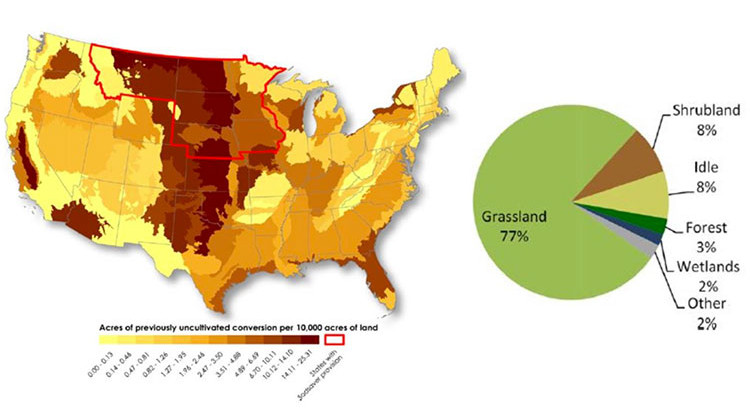
Left: Uncultivated land converted to grow crops from 2008 to 2012 (Lark et al., 2015) Right: Types of land converted for agriculture out of 7.3 million acres total.
Lark et al., 2015Conservation groups say the U.S. is illegally destroying wildlife habitat to produce biofuels. That has big implications for Indiana, where about 40 percent of our corn is grown for ethanol. The groups say the Environmental Protection Agency isn't enforcing a 2007 law.
The petition comes after President Donald Trump recently instructed the EPA to allow year-round sales of E15 gas.
At issue is a part of the Energy Independence and Security Act (EISA), which only allows land cultivated before 2007 to grow corn and soybeans for biofuels.
Instead of the EISA, the EPA has been adhering to a change in the Renewable Fuel Standard, which allows new land to be farmed as long as the total amount of farmland in the U.S. doesn’t go above 402 million acres. But Earthjustice attorney Carrie Apfel says just because cropland is no longer being used, doesn’t mean it’s being preserved.
“Land comes out of production for many reasons, for example, for urbanization,” she says.
READ MORE: 15 Percent Ethanol Gasoline Could Benefit Indiana Corn, Harm Wildlife
A recent report from the EPA estimates cropland in the U.S. has increased somewhere between 4 million and 7.8 million acres since 2007. Though the agency isn’t sure how much of that can be attributed to biofuels.
Nathan Fields with the National Corn Growers Association disagrees with those numbers. He says the U.S. Department of Agriculture’s data shows that while there’s more acres of corn and soy, crops like wheat, hay, and sorghum have gone down.
“It’s not due to native land conversion," he says. "It’s just simply a shifting crop mix in the U.S.”
There are now 14 ethanol refineries and five biodiesel plants in Indiana.
“So that’s adding pressure to our farmers to produce the feedstocks to those facilities,” says Tim Maloney with the Hoosier Environmental Council.
The groups say recent mandates to increase the use of corn and soybeans in gasoline have led to more habitat destruction, water pollution, and greenhouse gases.
Indiana Environmental reporting is supported by the Environmental Resilience Institute, an Indiana University Grand Challenge project developing Indiana-specific projections and informed responses to problems of environmental change.
 DONATE
DONATE








 Support WFYI. We can't do it without you.
Support WFYI. We can't do it without you.